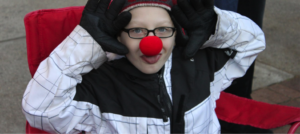Emotional Dysregulation – Just like Regular Kids but “Only More So!
Emotional Dysregulation – Just like Regular Kids but “Only More So!

A very dear friend and expert special educator insists that kids who have neurological disorder are just like regular kids – “only more-so!”
Let me explain what that confusing statement means…
Kids who have neurological disorders have feelings just like everyone else, except their feelings are so much more intense. They feel so much more of everything. They experience more joy when happy, (hence their hyperactivity), they feel more pain when injured (we think they’re over-reacting), more anger when frustrated or disappointed (leading to rage) and more sadness (also misinterpreted as over-reacting).

This evening, my stepson erupted into a fit of screaming and pounding the floor in a rage over homework, then back to a total recovery and calm. Soon after, he collapsed into a heap of tears as he suddenly recalled the death of his grandmother from the previous year. The intense grief lasted about 2 minutes, and he recovered once again, to join his friends in playing basketball.
I shouldn’t be surprised by his behaviour tonight. He was bound to fall from perfection at some point. He’s been stable and even tempered for months – and it’s due to consistency at home and at school.
Kids with neurological disorders are incredibly susceptible to change, as we all are – “only more so!”
Change has an effect on us all, to varying degrees. Some people abhor surprises, which is just another name for change. Kids with neurological disorders often fall apart in these circumstances that arise from change.
Emotional dysregulation can be observed as intense or extreme emotional responses to a situation, aggression, impulsivity, avoiding behaviours, difficulty calming themselves and difficulty knowing what emotion they are actually feeling and especially, drastic changes in mood.
My stepson’s chemistry and subsequent emotional state is totally dysregulated today for any number of reasons. From my own personal Tourette experience, I know he could be unconsciously reacting to the onset of the Canadian winter – with a reduction of daylight hours and cold temperatures. This always messed me up. It still does, sometimes. When his chemistry is thrown into flux like this, Nathan’s behaviour is erratic and (almost) manic. He can swing from one extreme mood to another. As well, he is dealing with another ill family member. Although he seems calm, he is very prone to experiencing a quick thought of concern, then bursting into tears from a memory of his late grandmother.
By keeping Nathan’s life consistent, we greatly reduce the occurrence of mood swings and emotional dysregulation. At times of change, it is important to stay connected to any consistency and predictability you can find. For example, on a trip during the holidays, we can expect Nathan to be extremely dysregulated and prone to mood swings.
His normal routine of waking, going to school, coming home and going to bed ceases.
In these cases, we keep eating and bed times consistent. We maintain sleep hygiene so he can slowly unwind and fall asleep at a reasonable time using his normal bedtime routine.
We give him ample warning of the plan of each day with frequent recaps and updates to give him time to process the upcoming schedule and reduce over reaction when the changes happen. Rules must be kept consistent, as well. There are no exceptions such as, “just this one time”, or “it’s the holiday”. There is no “flying by the seat of our pants” with our Nathan.
Keeping Calm
Meltdowns from emotional dysregulation can be minimized by maintaining routines, maximizing predictability, planning ahead, advanced warning of change and consistent rules.
For the times when dysregulation occurs, (and it will), it is helpful to keep in mind that kids with neurological differences actually do feel more, and they will respond more. They are just like regular kids – “Only More So!”


